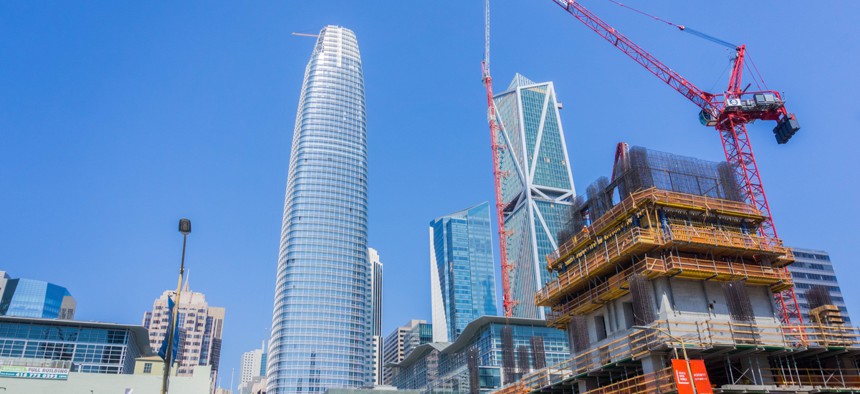How Do New 'Supertall' Skyscrapers in U.S. Cities Measure Up to the Rest of the World?

In this September 2017 photo, the Salesforce Tower, at left, in San Francisco's South of Market area nears completion. Shutterstock

Connecting state and local government leaders
San Francisco and Philadelphia are joining the ranks of global cities with towers that rise above 300 meters, a height that may seem puny across Asia these days.
The Salesforce Tower looms above San Francisco. The skyscraper, which is expected to open in early 2018, will be by far the tallest building in the city. At 1,070 feet (326 meters) it will be more than 200 feet taller than the Transamerica Pyramid Center, which has been San Francisco’s tallest building since 1972. The Tower is a sign of San Francisco rise as a center of economic dynamism, and the financial might of the cloud computing company that bears its name.
Philadelphia’s 1,121 feet (342 meters) Comcast Technology Center will also likely be completed in 2018. The building, which will be the city’s tallest, is less a sign of Philadelphia’s economic health than Comcast’s rapid growth over the last decade—the company’s valuation has more than quadrupled since 2009.
Salesforce Tower and the Comcast Technology Center will be their city’s first “supertall” buildings—defined by the U.S.-based Council on Tall Buildings and Urban Habitat as buildings over 984 feet (300 meters). Only New York, Chicago, and Los Angeles will have taller buildings. Atlanta and Houston are the only other US cities with supertalls.

Yet internationally, the new buildings in Philadelphia and San Francisco are not all that impressive. In 2018, 19 other supertall buildings are likely to be completed. Of those buildings, 14 will be in China, seven of which are taller than the Comcast Technology Center. The tallest of these will be the 1,483 feet (452 meters) Changsha IFS Tower located in south-central Chinese city of Changsha.
Neither Philadelphia or San Francisco will enter the top 25 cities in terms of tallest buildings. Philadelphia will place 27th just behind Xiamen, China; and San Francisco will be 36th behind Jiangyin, China.
Rank | City | Tallest building in feet
- Dubai: 2,717
- Shanghai: 2,073
- Mecca: 1,972
- Shenzhen:1,965
- Seoul: 1,819
- New York City: 1,776
- Guangzhou: 1,739
- Tianjin: 1,739
- Taipei: 1,667
- Hong Kong: 1,588
- Changsha: 1,483
- Kuala Lumpur: 1,483
- Nanjing: 1,476
- Suzhou: 1,476
- Chicago: 1,451
- Wuhan: 1,437
- Kuwait City: 1,354
- Riyadh: 1,263
- Dalian: 1,257
- Abu Dhabi: 1,251
- Nanning: 1,251
- Moscow: 1,226
- Shenyang: 1,150
- Xi'an: 1,148
- Kaohsiung: 1,140
- Xiamen: 1,128
- Philadelphia: 1,121
- Zhenjiang: 1,120
- Chongqing: 1,112
- Wuxi: 1,112
- Los Angeles:1,100
- Guiyang: 1,099
- Beijing:1,083
- Hanoi:1,078
- Jiangyin: 1,076
- San Francisco:1,070
- Yantai: 1,060
- Gold Coast:1,058
- Wenzhou: 1,056
- Zhuhai: 1,056
According to the Council on Tall Buildings and Urban Habitat, there are 120 future supertall buildings now under construction. Among these is the Jeddah Tower which, if all goes according to plan, will be the world’s tallest building at 3,281 feet (exactly one kilometer). It is expected to be opened for business in 2020. Of the supertalls currently under construction, 69 are in China. Only nine are in the US, all in New York and Chicago.

As my colleague Gwynn Guildford has pointed out, many of these future supertalls only make the grade by adding “vanity height” through features like spires above the top useable floor. For example, the world’s tallest building, Dubai’s 2,717 feet (828 meter) Burj Khalifa is 29 percent vanity height.
Dan Kopf is a reporter for Quartz, where this article was originally published.

NEXT STORY: Army site gives cloud migration teams a leg up




